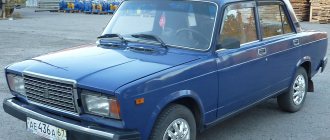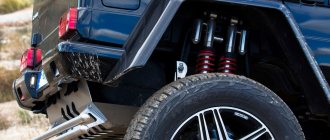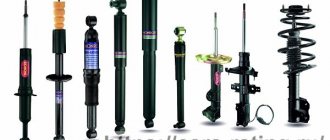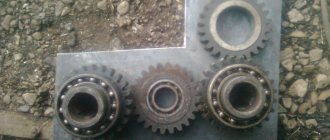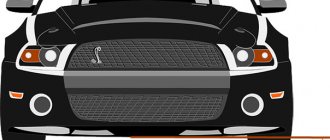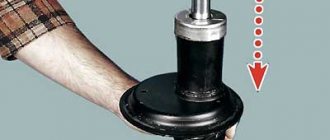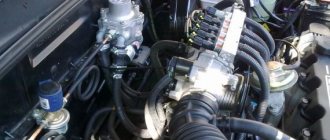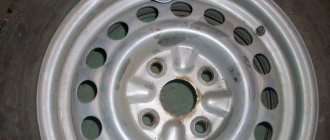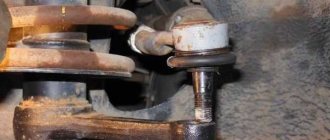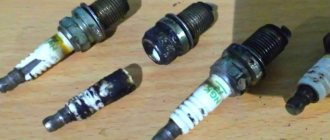What is a shock absorber
A shock absorber is an important part of a car suspension (suspension system), designed in such a way as to dampen vibrations and soften shocks and impacts of other related elements, as well as the vehicle body, when driving on uneven roads. The shock absorber must ensure smooth movement of the car and prevent it from swaying.
Shock absorbers are parts in a car that increase the adhesion of tires to the road surface, which, in turn, ensures the vehicle's steering control, improves stability and timeliness of the braking system.
Purpose of shock absorbers
Working together with springs, springs or other elastic elements, the damping device solves important problems:
- Slows down and extends sudden deformations of elastic elements over time.
- Absorbs part of the vertical loads transmitted to the frame (body) of the machine.
- Prevents the occurrence of resonant oscillations.
- Maintains constant contact of the wheels with the road.
The smoothness of the vehicle and its controllability on difficult road sections directly depends on the serviceability of the shock absorbers.
The history of the shock absorber
Shock absorbers, also called dampers (softening devices), did not appear in their usual form immediately. At the beginning of the automotive industry, springs were used in the designs of self-propelled vehicles, which quite cope with the function of smoothing out vibrations at low speeds.
The need for improvement became obvious to the drivers of the first sports personnel, and already at the beginning of the 20th century, Mors cars received friction shock absorbers.
The shock absorber device was simple, cheap to produce, but the parts wore out quickly. However, their exploitation continued until the 60s. last century.
The first hydraulic models began to be used in the 30s. The design of such shock absorbers had a one-way action principle (oscillations are damped at the moment of spring recoil). Later, devices appeared that worked not only during rebound, but also during compression (double action), which significantly increased the efficiency of dampers.
This type of model was called lever due to the presence in the design of a special lever that moves a pair of pistons that press the liquid through the holes. Due to this, the impulse was extinguished.
Gradually, lever shock absorbers replaced telescopic shock absorbers, which are now equipped in all passenger cars. The control of these important suspension parts is entrusted to the on-board computer, which regulates the operation and selects the best operating mode.
Design and principle of operation of shock absorbers
Since the appearance of the first cars, designers have been faced with the question of finding the optimal way to dampen body vibrations that arise when overcoming bumps. The best solution, still used today, was the integration of special devices - shock absorbers - into the car suspension. At the moment, hydraulic telescopic shock absorbers are widespread. Damping of vibrations of the body and wheels occurs in them due to fluid friction that occurs when fluid passes through narrow holes in the piston - valves. Thus, the mechanical vibration energy is converted into thermal energy. Such important indicators as stability, controllability and smoothness of the vehicle depend on the characteristics of shock absorbers. Modern shock absorbers, based on a general operating principle, differ in types and design features.
Why are shock absorbers needed?
The name of the part “shock absorber” (amortisseur) translated from French means “damper”, “soothe”, which perfectly conveys its purpose and function.
The car's suspension system serves to connect the wheels to the body, but also ensures reliable contact of the tires with the road and eliminates excess vibrations that occur during movement, providing shock absorption.
When the suspension is rigidly connected to the body, impacts from road unevenness are transferred to the body almost in full. The large amplitude of vibrations and vertical acceleration lead to significant shaking and bouncing of the vehicle.
Dampers are designed to absorb vibration energy, smooth out shocks, in addition, they stabilize the car and prevent swaying during acceleration, braking and cornering. The trip becomes more comfortable and safe as the vehicle's stability and controllability increase.
Summary of signs of shock absorber failure
Keep a small sign that clearly shows the main criteria for diagnosing racks discussed above, and the signs of different conditions - from ideal to rubbish.
Signs | Ideal | It might also be like | Trash |
| Smudges | Dry | There is a small leak | Wet and covered with centuries-old dust |
| Corrosion | Shines | Not shiny, but not rusty either | Rust, rot, corrosion |
| Anther | Whole, elastic and in place | Oak, but still intact and in place | Torn, cracked, slipped |
| Sleeve | Elastic, alive | Oak, but not deformed | Oak, cracked, squeezed out |
| Sway test | Freezes to the spot, returning to its original position | It swung upward once, but then sank and stopped. | Swings more than twice |
| Smooth road | The car confidently “holds” the road | Rocks or yaws for no reason | |
| Maneuvering | Little roll, instant stabilization | Noticeable roll, but no swaying | Heels heavily, and after exiting the turn continues to sway |
| Braking | One “nod” or “bow” is allowed | After the “nod” he continues to “bow” | |
| Pits | "Swallows" | There are slight impacts on the steering wheel, no knocks | Unpleasant blows to the hands and distinct knocking sounds |
| Potholes | |||
| Heat | Everyone is equally warm | One or two are a little colder than the rest | Very noticeable difference in heating |
How does a shock absorber work?
Despite the emergence of new developments, the design and operating principles of shock absorbers remain unchanged. Depending on the type of part, it contains liquid or gas inside. Moving under pressure, the viscous shock-absorbing component (oil) passes through small-diameter holes. The higher the load on the suspension, the stronger the resistance.
The kinetic energy of vibrations is converted into thermal energy; during compression, the internal component of the part heats up. Subsequently, the heat is released through the housing into the environment. This is the operating principle of shock absorbers.
The principle of operation of shock absorbers
All shock absorbers operate on the principle of converting kinetic energy into thermal energy. The specific type of such transformation is determined by the type of shock absorber: hydraulic, friction, relaxation.
Shock absorber classification
Single-sided shock absorber
With a shock absorber of this type, the resistance during the stroke corresponding to the compression of the suspension is insignificant, and the main absorption of energy occurs during rebound. Thanks to this, they provide a slightly smoother ride, however, as road unevenness and speed increase, the suspension does not have time to take its original position before the next operation. this leads to “breakdowns” and forces the driver to reduce speed. With the introduction of double-acting shock absorbers around 1930, the single-stroke design gradually fell out of use.
Double-sided shock absorber
A shock absorber that acts (works) in two directions, that is, the shock absorber absorbs energy when the rod moves in both directions, however, at the same time transferring some of the shock force to the body during forward stroke. This shock absorber design is more efficient than a single-sided shock absorber in the sense that it can be built to accommodate the necessary compromise between ride quality and vehicle stability on the road. High-speed cars are characterized by more “hard” settings, while comfortable passenger cars are characterized by “softer” settings, where most of the shock absorber’s work occurs during rebound.
In vehicles, as a rule, the efficiency of the “working stroke” of the shock absorber (compression, collision of the wheel with an obstacle) is less than the efficiency of rebound (reverse movement). In this case (when compressed), the shock absorber transmits shocks from unevenness less to the body, and (when stretched) “holds” the wheel from being hit by the spring against the bottom of potholes in the road.
Friction shock absorbers
Frictional (mechanical) shock absorbers in the simplest case are a rubbing pair with a fixed compression force. A design with resistance proportional to movement, with operatively adjustable force, etc. is possible. An obvious property of friction shock absorbers is that their resistance is independent of the speed of movement of the lever. Therefore, they are literally dampers, since they perform only one of the functions specified in the definition of a shock absorber - damping vibrations. Advantages: simplicity and relative maintainability, reduced requirements for machining of parts, operating conditions, resistance to minor damage. The fundamental disadvantages are irreparable wear of the rubbing surfaces and the presence of some starting force, which is impossible to get rid of without complicating the mechanics. As a result, this type of shock absorbers has not been used on cars for a long time, remaining only on certain types of military equipment. Also, in light and/or low-speed vehicles (mopeds, tractors, etc.), the role of a friction vibration damper can be played by friction between suspension parts.
How do car shock absorbers work?
Modern shock absorbers are designed the same and have:
- Hollow steel cylinder. It is plugged on one side and filled with gas or liquid. On the other hand, it is tightly closed with a rod seal so that the shock-absorbing component does not come out.
- Stock. It is a steel rod of different diameters (depending on the car brand), which fits into a reservoir with a shock-absorbing component (oil/gas) and is attached to the piston.
- Piston. Necessary to create pressure inside the part.
- Throttle and check valve. One group is activated during compression, the other during reverse stroke. Other valves are located at the bottom of the cylinder. Single-pipe models have a floating valve in their design, which separates the oil and gas components of the damper.
Twin-tube shock absorbers
Where : Cadillac CT6, Chevrolet Impala, Ram 1500
As the name implies, shock absorbers of this type consist of two concentric cylinders. The inner cylinder is filled with oil and also contains a piston and rod. As in monotube shock absorbers, a rod with a piston moves inside the cavity, on which valves are mounted that determine the forces of both rebound and compression. An additional foot valve directs oil to the outer cylinder (reservoir) during compression, increasing the damping ratio. During rebound operation, the oil returns to the main chamber reservoir through the control valve. The outer cylinder is partially filled with compressible gas, which compensates for the released volume of the rod and helps oil from the outer cylinder enter the inner cylinder during rebound operation. The balancing force is determined by the same factors as in monotube shock absorbers, but with the additional influence of the bottom valve. The twin-tube shock absorber is adjusted by adding or removing washers.
Types of shock absorbers
There are several types of shock absorbers:
- Based on the design: single-pipe and double-pipe.
- Depending on the filling: oil and gas-oil.
- Using the capabilities of the electronic control unit (ECU): adaptive (adjustable) and pneumatic.
It should be understood that the above division is conditional. Models combine two or more species characteristics.
Monotube and twin-tube shock absorbers
The basis of the design of a single-pipe damper is a single hollow pipe, in the lower part of which gas under pressure is placed, separated from the liquid by a floating piston (valve). Such devices have a number of advantages: they can withstand heavy loads, operate stably, dampen vibrations better, and cool quickly. Disadvantages: elongated size, instability to mechanical stress, high price.
In twin-tube shock absorbers, the oil-filled working cylinder is located inside a larger tube (reservoir). The piston placed in the cylinder moves downwards (compression occurs) and squeezes oil into the device body, and on the return stroke it passes liquid into the cylinder through the valves.
Oil and gas-oil
The working fluid of oil (hydraulic) shock absorbers is oil, which flows from one section to another. Oil models are considered more rigid, since the internal component is not compressed and the piston stroke is possible only due to the operation of the valves.
Gas-oil (gas) devices dampen vibrations better and are softer. However, gas models (not counting those where the gas is separated from the oil by a special piston) have a significant drawback. Gas and oil mix, which disrupts the operation of the part, reduces its efficiency and leads to failure.
Currently, engineers and mechanics, by changing valve settings, cylinder volume, etc., are ensuring that oil shock absorbers become softer than gas shock absorbers. But when comparing specimens with similar parameters, the initial statement about their rigidity remains true.
Adjustable Designs
Many modern models have an electronic component, with the help of which it becomes possible to change the properties of shock absorbers during operation.
Thus, changing the cross-section of the solenoid valve increases or decreases the damper stiffness.
If the device uses an innovative liquid with metal particles, then the effect of a magnetic field instantly changes the structure of the substance and the rigidity of the part. The use of such devices makes it possible to best adapt the car to changing road conditions, but they are quite expensive.
Pneumatic version
Pneumatic models are more complex in design, but more durable and do not overheat. Oil replaces air in them. To operate, such devices require a compressor and an air supply recorder; control is carried out electronically (ECU).
The peculiarity of pneumatics is that the vehicle’s position is adjusted both while driving and at rest. An overloaded machine does not sag. The driver can also change the parameters at his discretion (increase the clearance, for example).
How to replace shock absorbers
Replacing shock absorbers is carried out in the following sequence.
- Raise the car on a lift. If it is raised with the help of jacks, then when changing the front shock absorbers, the car must be put on the handbrake, and when installing the rear ones, the gear must be engaged (in rear-wheel drive cars, the front wheels must be blocked in a different way, for example, using wheel chocks).
- Unscrew the fastening on the steering knuckle.
- When replacing the front struts, the steering tip is removed.
- Unscrew the rod mount on the support bearing.
The rack is installed in the reverse order.
The example of a VAZ 2111 shows how the procedure is performed:
Replacing front shock absorbers VAZ
Recommendations from professionals:
- Before installing a new strut (applies to a two-pipe modification), the shock absorber must be pumped so that the air leaves the working cylinder. If this is not done, then “dips” of the piston will appear while driving. Pumping is carried out as follows: the shock absorber, turned upside down, is smoothly compressed, fixed for 2-3 seconds, in this state it is turned over and after 3-5 seconds. release smoothly. Then the rack is turned over with the rod down, wait a couple of seconds, and repeat the procedure three or four times. After bleeding, the shock absorber should be stored in a vertical position, just as it will be installed on the car.
- Do not use a pneumatic impact wrench to tighten the rod mount. Because of this, the rod may turn and damage the seal. If this does not happen, over-tightening will create tension in the shock absorber rod, due to which it may break over a large bump.
- It is strictly forbidden to fix the rod with pliers or other clamping tools. This will damage the rod mirror. To fix it, use a special key.
- Before final tightening of the rod nut, the vehicle must be lowered from the lift or jack. This way the rod will be twisted evenly and will not break or break the silent block while driving.
Motorists disagree about the comprehensive replacement of shock absorbers. Some believe that all the racks need to be changed at once, while others are sure that replacing the damaged part is enough.
Although each motorist decides for himself how to repair his car, experts insist on pair replacement - even if one is faulty, then replace both on the side (either front or rear). Due to fatigue wear, old parts combined with new ones can significantly reduce the efficiency of the entire assembly. In any case, remember: one faulty part can negatively affect other important suspension or chassis components.
The best European shock absorbers
German and Dutch companies are considered the best manufacturers of dampers and other components for automobile transport. World-famous companies set the bar for standards, quality and prices. Their products are durable, perform their functions at the proper level and are worth the money.
Bilstein
Bilstein is a German company founded in the 19th century. Since the 20s In the last century, the company refocused on the production of automotive components (chrome parts). The company began producing shock absorbers in 1954 for Mercedes.
Bilstein produces all types of damping devices and other suspension parts. Bilstein dampers are of high quality, adjustable to the characteristics of the road, wear-resistant, but quite rigid. The product price is high.
Koni
The market leader is the Dutch company Koni. It produces shock absorbers for both sports cars and economy cars. The product line includes more than 2,500 models for any car.
The Koni product guarantees a soft ride, stability during maneuvers, and can withstand significant loads. Adjustment and adaptation to the owner's needs is possible.
Boge
A German brand that supplies spare parts not only to car assemblers in Europe, but also in Asia and America. The service life of Boge parts is high thanks to the use of processing technologies for components (micropolishing, chrome plating), as well as special oils and seals that are resistant to high temperatures.
Boge distinguishes three lines of dampers: Automatic (for auto assembly plants), Turbo (sports cars) and Extreme (withstanding increased loads).
Trw
Another manufacturer from Germany, specializing in components for cars and trucks. Like Boge, it is a supplier of components and mechanisms for European assemblers.
In addition to shock absorbers, TRW is known as a manufacturer of cylinders, brake fluids and lubricants, brake pads, cables and pumps. The quality of the parts, according to reviews from car enthusiasts, is average, but the price is affordable. The company's product range is wide, containing components for most models of the global automotive industry.
The best Asian shock absorbers
Products of Japanese and Chinese brands have taken a strong position in the market due to the low cost of the products, which allows them to be installed on inexpensive cars. The quality matches the price and suits many buyers as the best option.
Tokiko
At a time when American and European factories take a different approach to assessing the quality of products depending on whether it goes to the assembly line or to the secondary market, Tokico refuses such a division. Therefore, the products of the Japanese company are always of high quality.
After merging with Hitachi in 2004, the company's products became available to Russian consumers. Excellent quality characteristics and low cost have earned the trust of our car enthusiasts.
The disadvantages of softening devices from Tokico include the possibility of failure before the stated period.
Kayaba
Kayaba (Japan) is considered the world's leading manufacturer of hydraulic equipment. KIA, Toyota, Chevrolet are equipped with KYB components. They are widely represented on the spare parts market.
Consumers comparing shock absorbers from Tokico and KYB find similarities. But Kayaba products are more common. The growing popularity of components in Russia is influenced by the average price, good quality, and the presence of a factory guarantee.
Sensen
A Chinese manufacturing company seeking to repeat Kayaba, but with prices 1.5-1.8 times lower and an individual approach to the client. Just call your Sensen representative in your city to receive product information with photos via email the same day. The company's assortment is small, covering products intended for passenger cars.
Reviews about Sensen shock absorbers are more positive. The devices are equipped with Japanese NOK oil seals, bushings with a protective Teflon coating, steel, chrome-plated rods, and contain Eneos oil (semi-synthetic). The rigidity of the devices is optimal, and the resistance to short overloads is high. Shock absorbers from Sensen can withstand approximately 50-100 thousand km, depending on the condition of the road, but quickly break down after the warranty expires.
Miles
The company's head office has a Belgian address, but production is located in Asia (China, South Korea, Taiwan). The company supplies components to the secondary market in Europe, and has recently begun to expand into Eastern Europe and Russia.
Miles produces spare parts for brake systems, suspensions, transmissions, as well as various fluids.
Despite the high technology and robotization of many production areas, the quality of products, in particular shock absorbers, according to consumer estimates, is average. The dampers are very hard and quickly fail.
Patron
The brand's components are produced at 70 factories scattered around the world (including in Russia). The products are certified, meet international standards, and are included in the TacDoc catalog.
Analogues from Patron are 20-40% cheaper than the originals, but the quality will be lower. The manufacturer provides a one-year warranty (=20 thousand km) for all products, which is relatively little.
Patron demonstrates a wide range of products, which includes both chassis components and electronics, optics and consumables. Despite the fact that the electronics products are not of high quality, the shock absorbers and other suspension parts are quite good.
The damper filler has special additives that prevent foaming, the cooling system is improved, and the rigidity changes in adaptive models. At a low cost and quality comparable to the original, Patron shock absorbers are a good solution for a car.
Shock absorber device
The shock absorber consists of a steel reservoir 4 (29) connected by welding to the lower mounting eye 1; Inside the tank, a working cylinder 13 (30), made of a steel pipe, is freely placed. From below, a compression valve is pressed into the working cylinder (all the way to the end), which consists of a housing 2, a valve 39 inserted into it with a spring 40 and a valve seat 3. The valve seat is screwed into the body; its position is selected in advance according to the given hydraulic characteristic of the compression valve, and then is controlled by a limit nut 38, which, in turn, has a collar that serves as a stop for the spring sprocket 6, which presses the intake valve plate 5 towards the plane of the compression valve.
Rice. Shock absorbers of car wheel suspensions: a - front; b - rear; 1 — lower mounting eye; 2 — compression valve body; 3 — compression valve seat; 4 — front shock absorber reservoir; 5 — intake valve plate; 6 — intake valve sprocket; 7 — adjusting washer; 6 — spring of the front shock absorber recoil valve; 9 — recoil valve disc; 10 — throttle disk of the front shock absorber recoil valve; 11 — bypass valve sprocket; 12 — restrictive plate; 13 — working cylinder of the front shock absorber; 14 — front shock absorber rod; 15 — rod guide; 16 — oil seal spring; 17 — reservoir seal; 18 — oil seal cage; 19 — seal ring; 20 — lock ring of the front shock absorber; 21 — thrust ring of the front shock absorber; 22 — upper mounting eye; 23 — rear shock absorber rod; 24 — tank nut; 25 — pressure washer; 26 — felt seal of the rod; 27 — rubber stem seal; 28 — rear shock absorber casing; 29 — rear shock absorber reservoir; 30 — working cylinder of the rear shock absorber; 31 — bypass valve plate; 32 - piston; 33 — throttle disc of the rear shock absorber recoil valve; 34 — recoil valve plate; 35 — recoil valve adjusting washer; 36 — rear shock absorber recoil valve spring; 37 — recoil valve nut; 38 — intake valve limit nut; 39 — compression valve; 40 - compression valve spring
Rod 14 (23) is made of carbon steel. The working surface of the rod 14 of the front shock absorber is coated with a layer of chrome and polished. Rod 23 of the rear shock absorber is polished without coating with a layer of chrome. At the upper end of the rod 14 of the front shock absorber there is a groove cut for the locking ring 20, which secures the thrust ring 21.
The upper end of the rod 23 of the rear shock absorber is welded by contact welding to the upper mounting eye 22, and a casing 28 is welded to the flange of the eye, protecting the rod and seals from direct contact with dirt and moisture. At the lower end of the rod, a nut 37 secures the piston 32 with the parts of the recoil valve and bypass valve.
The recoil valve includes a throttle disk 10 (33), covering eight piston holes located along the circumference closer to its axis, a disk 9, a set of thin adjusting washers 35, a plate 31, a calibrated spring 8 (36), a nut 37, screwed in until it stops, and set of adjusting washers 7.
The bypass valve consists of a restrictive plate 12 with a washer, a spring sprocket 11 and a plate 31 that closes the bypass holes of the piston, located along the circumference further from its axis.
The working cylinder is closed on top by a rod guide 15 made of zinc alloy. Inside the guide there is a metal-ceramic bushing along which the rod moves. The felt seal 26, located under the reservoir nut, protects the internal cavity from the penetration of dirt, and the internal rubber seal 27, installed in the holder 19 and pressed by the spring 16 through the holder 18, prevents fluid from leaving the shock absorber. To seal the tank, a sealing gland 17 is placed between the cage and the rod guide, which is compressed through the fiber washer 25 when the nut 24 is tightened.
[custom_ads_shortcode1]
The best American shock absorbers
It’s not for nothing that American manufacturers have high ratings from experts. The brands' products are competitive, high-quality, and have earned trust over the years of conscientious work.
Monroe
The world's largest manufacturer of shock absorbers, owned by Tenneco Inc. (Illinois). Four factories located in England, Belgium and Spain produce 90 thousand products daily, 2/3 of which go to conveyors, 1/3 to the spare parts market.
The company's product range is wide, and the product quality is consistently high. Monroe is one of the few companies that can produce shock absorbers for any brand of car.
The consumer can choose a spare part to suit his taste: wear-resistant and rigid models for long-term city driving, options for extreme conditions with high stability and minimal vibrations, expensive models with a five-year warranty. The cost of the spare part is in the above-average price category, but looks attractive considering the characteristics of the brand.
Rancho
The Rancho company is part of the Tenneco concern, like Monroe, so the production of shock absorbers, suspension and steering parts, as well as auto-tuning components is carried out at a plant in Nebraska.
You can purchase Rancho products anywhere in the world.
The company specializes in parts for SUVs. Rancho shock absorbers have a dual-circuit design, sensors that monitor the speed of the rod, five levels of stiffness, and Teflon-coated parts. The cost is high.
Delphi
A company with a huge range of products. In addition to shock absorbers, Delphi produces and markets sensors, steering parts, pumps, filters, etc. The company is known for reasonable prices and medium-high quality workmanship.
The robust working tube design of Delphi Twin Tube Damping Units is designed to protect the cylinder from external damage. The shock absorber is a gas shock absorber and contains gas under pressure; it also has increased heat resistance and more accurate valve operation. Single-pipe models are designed for luxury cars and off-road vehicles.
ACDelco
General Motors brand. The company is engaged in the production of spare parts for GM cars, their maintenance and repair. The range is extensive: filters, bearings, pumps, shock absorbers, chassis elements, brakes, belts, etc.
Twin-pipe gas damper devices have a chrome-plated (corrosion-resistant) rod, seamless working cylinder, and durable piston valve. The warranty for ACDelco products is 12 months.
Design and operation of shock absorbers
Hydraulic telescopic shock absorber
Hydraulic telescopic shock absorbers are distinguished by the fact that they are structurally made in the form of two-pipe ones, and use only liquids as the working fluid.
In Fig. Figure 1 shows a typical design of a telescopic shock absorber used on domestic cars.
The piston 14 is connected through the rod 18 and the upper eye 1 to the supporting system (frame or body) of the car. The pipe 16, in which the cylinder 17 is fixed, is connected to the wheel through the lower eye 1. The piston 14 divides the working space of the cylinder 17 into two cavities. In the upper part, the rod 18 moves in the guide sleeve and is sealed with a sealing collar located in the holder 3. The seal is pressed by a special nut along the threads of the pipe 16 to the guide sleeve, and is pressed against the cylinder 17. Thus, the shock absorber has three cavities: in the cylinder above the piston , under the piston, as well as between the cylinder 17 and pipe 16.
At the bottom of the working cylinder there is a housing in which an inlet valve 9 and a compression valve 10 are installed, pressed by a spring 11. These valves close the holes 13 and 12 located in the housing.
How to choose shock absorbers
The choice of shock absorbers depends on the make of the car, since not every one is suitable in terms of technical characteristics and parameters.
If the question of purchasing a damper has arisen for the first time, you need to consult with specialists in auto parts stores, where they will help you choose the right model from the catalog.
The choice should be made based on the feasibility of using certain shock absorbers for a particular car, because incorrectly selected models can cause harm to other vehicle systems. It is important to consider the price of the part, which should be optimal.
What it is?
A shock absorber in a car is a piece of equipment in the car. The element is designed to dampen the force of vibrations, shocks, or possible impacts of elements that differ in movement dynamics. The shock absorber helps keep the body of the car under control. If a shock absorber is installed in a car, the operation becomes smooth, uniform, and comfortable. Functioning is carried out by converting mechanical energy into thermal energy while the machine is running. Shock absorbers function in combination with other elements, such as springs or leaf springs.
The first hydraulic shock absorber appeared on the parts market in 1908; Louis Renault received a patent for its development. After 30 years, horizontal parts entered the market, the operating principle of which was to twist a spring.
Shock absorbers help the vehicle move smoothly without sudden movements. If you remove a part from the car, the movement will be similar to moving on a cart, that is, passengers will feel every bump and bump in the road surface.
The standard vehicle model comes with four shock absorbers to balance movements on all sides.
The car parts form a connection with the shock absorber elements and can perform the following fundamental options:
- stop vibrations in the area of the wheels and vehicle body;
- control of wheel contact with the support surface;
- the vehicle can move smoothly.
The principle of operation of the part is that the energy that occurs during fluid friction is converted into thermal energy. The rod moves in combination with the piston, causing oil to flow through specially designed holes. The work is designed to withstand resistance while moving. The rod can stop the shock absorber bump stop. The main stress goes to the apron of the part, so they are made stronger.
Main malfunctions and their symptoms
The most common shock absorber defects:
- Rod seal rupture.
- Worn piston and valves.
- Violation of the integrity of the body, deformation of the rod, destruction of parts of the device.
- Depressurization (loss of oil/gas).
It is not always possible to determine a breakdown by visual inspection. Characteristic signs may indicate this: Shaking, extraneous noise, vibration, the car sways during braking and during acceleration. As a rule, serviceable damping devices do not allow more than 1 oscillation even during a sudden stop. The presence of additional swings indicates a breakdown.
When maneuvering (changing lanes, making a sharp turn), the car should not hesitate. An increase in braking distance is a consequence of the body swaying when trying to stop the vehicle. The front of the car lowers and rises, reducing the load on the tires, which slows braking.
Constant rocking of transport can lead to seasickness. Most often, this indicates a problem with the rear suspension parts.
How to check the shock absorber?
Upon visual inspection, it can be noted that oil from the shock absorber has begun to leak, or the body has begun to fog up. This indicates a seal failure. How can I check this? It is best to remove the devices and bleed them. If this is not possible, then you need to press hard over the pillars (alternately in the 4 corners of the car) and release sharply. If the device is working properly (even partially), then the body will return to its normal position after 1-2 oscillations. If the car rocks for a long time and knocking noises are heard, this means that the shock absorbers are faulty.
The most accurate way to identify faulty shock absorbers is only in specialized car services on a stand (shock tester). At the same time, each axle of the car is rocked and the vibration damping indicator is measured, and then they are compared with the reference values.
Video: How to check a shock absorber for performance, or the simplest way to determine a malfunction
A car's shock absorber is one of the most important devices included in the suspension. If it were not there, then driving the car would not only be inconvenient, but also dangerous due to the constant vibrations of the body. Rear and front dampers will provide excellent control even during aggressive driving and provide a comfortable ride even when driving on rough roads.
Which shock absorber design is better to choose? If you prefer comfort, take oil ones, and if controllability and control are important to you, then single-pipe gas devices are suitable.
Repost and the information will always be at hand ✅
